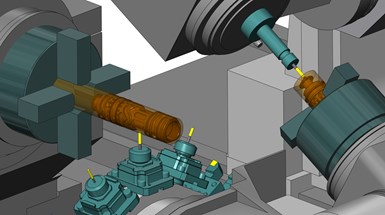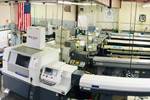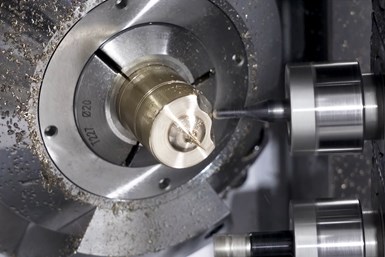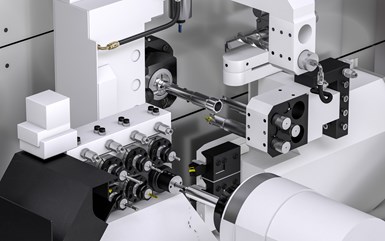Generating More Efficient Milling Tool Paths for Multitasking Machines
This toolpath generator can reduce cycle time and extend tool life while helping achieve better surface finishes for milling operations on multi-axis Swiss-types and turn-mills.
To enable shops to become more efficient with milling operations on multitasking machines, SolidCAM has developed its iMachining toolpath generator within the company’s CAD/CAM software. Photo Credits: SolidCAM
Because they offer the potential to machine parts complete is one reason shops are drawn to turn-mills and Swiss-type lathes. And, as part geometry continues to increase in complexity, there are cases in which just as much — if not more — milling is performed on those machines than turning.
To enable shops to become more efficient with milling operations on multitasking machines, SolidCAM has developed its iMachining toolpath generator within the company’s CAD/CAM software. The toolpath generator is said to be able to reduce machining time by as much as 70% and increase tool life.
It does this by employing high-efficiency milling to reduce cycle times by using solid end mills, small stepovers, fast feed rates and deep axial depths of cut. The company says the key to achieving the high material removal rates is generating optimized, morphed spiral tool paths with variable cutting angles and feed rates at every point of the tool path that creates a constant spindle load.
This strategy avoids shocks that occur when material engagement changes abruptly such as when a tool enters the corner of a pocket. Without this capability, feed rates must be managed for the worst-case cutter load scenarios, making cycle times longer. Moreover, maintaining a constant spindle load substantially reduces vibrations, thus yielding increases in tool life as well as better surface finishes.

The ability to visualize simultaneous operations on a single screen enables building a better-balanced program with faster cycle times.
The ability to visualize simultaneous operations on a single screen enables building a better-balanced program with faster cycle times.
Because multitasking machines are significant investments and might not have a large tool capacity, shops need the ability to compress machining time, yet extend tool life as much as possible. According to SolidCAM, that’s what iMachining does.
One could conclude that because this software is more aggressive with the cutting speeds and feeds that a tool would wear out quickly. But the company says that is not the case. Carbide is an extremely hard material — it can stand up to compressive forces beyond most other materials, and it is also highly resistant to abrasives. These factors make it well-suited for cutting tools used for cutting steel, superalloys and most other metals.
However, carbide is also very brittle and therefore does not stand up well to tensile (bending) force. The iMachining is designed to ensure that the carbide substrate at the sharp edge of the solid carbide tool flute never sees tensile force — it only sees compressive force. Therefore, the sharp edge resists microchipping, even at elevated performance levels, resulting in improvements to tool life, the company says.
Another way the software increases tool life is with its ability to make use of the full cutting depth of the tool while never overstressing the tool. It is designed to spread the forces over a large area, maximizing tool life by using the full length of the flute instead of only the bottom 10% as might be the case for traditional milling practices.
The toolpath generator can be especially useful on Swiss-type machines when milling with small-diameter tools.
The toolpath generator features several automatic abilities that increase ease-of-use for the machine operator. Its Technology Wizard, for example, is designed to eliminate practically all the guesswork involved with setting the machining parameters. The user chooses the level of aggressiveness by using a slider to adjust on a scale of 1 to 8, which alters cutting data to achieve higher material removal while staying within the constraints of the machine and cutting tool. Then, the Technology Wizard automatically calculates optimal feeds and speeds.
Other automatic characteristics include iMachining 2D, which handles the roughing, semifinishing and finishing of prismatic parts. The iMachining 3D replaces multiple standard roughing and semifinishing operations of complex 3D shapes in one step.
The toolpath generator can be especially useful on Swiss-type machines when milling with small-diameter tools. For example, a 0.015-diameter end mill at the full depth of cut can be routinely used. Even smaller tools can be accommodated based on the way that iMachining controls the engagement angle (radial depth of cut).
SolidCAM also provides other functionality to streamline and simplify programming of multifunction machines, such as:
- Integrated simulation. This is said to offer a fast, safe and effective way to generate validated code. Because it simulates synchronized channels throughout the process, it enables programmers to balance simultaneous operations more easily.
- Virtual Machine ID. With this function, users can tailor the software for a specific machine by defining electromechanical elements such as maximum spindle horsepower, speed and feed rates.
- Machine Control Operation. For turning centers with a subspindle, this function synchronizes part transfers and pick offs automatically.
- Toolpost management. Tool Table enables managing of the toolposts with predefined tool assemblies. Special functionality for Swiss-types enables direct entering of tool setup values to the software.
- Multichannel Synchronization. Mill-Turn and Swiss Multichannel Synchronization specializes in factoring in the machine kinematic limitations and the controller limitations when synchronizing parallel multiple tasks.
SolidCAM | solidcam.com/en-us
Related Content
Who Are the DFM Consultants? You Are.
Modern shops are bolstering their engineering staff to better offer design for manufacturability advice to their customers. Here, one industry expert suggests ways to develop a common language between manufacturing and engineering.
Read MorePrecision Machining Technology Review: December 2024
Production Machining’s December 2024 technology showcase includes some of the latest technology from Hexagon, Kennametal, SmartCAM, Horn and SMW Autoblok.
Read MoreHow to Start a Swiss Machining Department From Scratch
When Shamrock Precision needed to cut production time of its bread-and-butter parts in half, it turned to a new type of machine tool and a new CAD/CAM system. Here’s how the company succeeded despite the newness of it all.
Read MoreMastercam Software Improves Programming Flexibility
IMTS 2024: Mastercam introduces Mastercam 2025, with features including Mastercam Deburr for automated edge finishing, finish passes, mill-turn support for Y-axis turning and automatic license update notifications.
Read MoreRead Next
CAM System Helps Company Improve Programs for New Machine
A machine shop’s old CAM system held it back from efficiently using its new three-turret turning center, but upgrading its software has helped it save time and money.
Read MoreSwiss Shop Chooses CAM Over Hand Programming
This shop’s manual (by hand) CNC programming was slowing it down until it discovered a CAM software for Swiss-type lathes.
Read More5 Aspects of PMTS I Appreciate
The three-day edition of the 2025 Precision Machining Technology Show kicks off at the start of April. I’ll be there, and here are some reasons why.
Read More













.jpg;maxWidth=300;quality=90)










